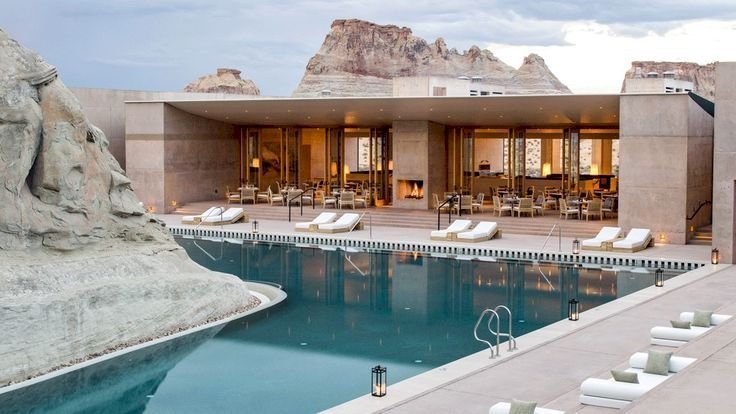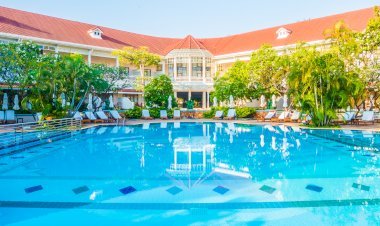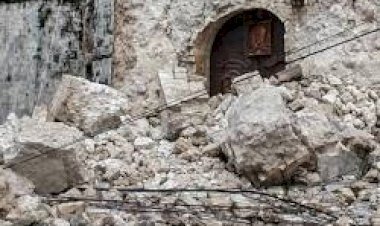Luxury Business Retreats: Destinations, Planning & Trends for 2025
Discover the top luxury business retreats in the U.S. for 2025. Learn how to plan, budget, and choose the best destinations, trends, and tools for success.

In 2025, luxury business retreats are no longer just a corporate perk—they’re a strategic priority. With over 72% of U.S. companies now offering offsite retreats as part of their annual leadership or team-building plans (according to a 2024 Forbes report), these experiences have become a proven way to improve productivity, boost morale, and strengthen workplace culture. The fast rise of hybrid and remote work has left many teams feeling disconnected, leading to a 35% increase in employee burnout reported by Gallup. Businesses are now recognizing that Zoom calls and emails can’t replace real connection.
That’s why companies—ranging from startups to Fortune 500s—are booking stunning destinations across the U.S. for immersive retreats that blend relaxation, strategic planning, and wellness. From private beachfront villas in Florida to eco-resorts in the Rocky Mountains, today’s retreats are designed to inspire and align teams in meaningful ways. In this article, we are going to explore the top destinations, planning steps, key trends, and business benefits of luxury business retreats in 2025.
Why Companies Are Choosing Luxury Business Retreats in 2025

In 2025, an increasing number of U.S. companies are turning to luxury business retreats as a practical solution to strengthen team performance, improve morale, and drive innovation. These retreats are no longer seen as simple getaways—they’ve evolved into purposeful experiences designed to support employee well-being and sharpen business strategy. As workplace stress continues to rise and remote work creates physical distance between team members, more employers are realizing the value of bringing people together in inspiring settings away from daily pressures.
According to HR industry surveys, businesses that invest in offsite retreats report improvements in team communication, leadership alignment, and employee satisfaction. These retreats offer an opportunity to step back from packed calendars and focus on the bigger picture. Instead of back-to-back meetings, teams engage in meaningful group workshops, mindfulness sessions, outdoor activities, and guided leadership discussions. These hands-on experiences help spark creative thinking and build trust in ways traditional office settings often can’t.
Whether it’s hiking through the forests of Montana, practicing morning yoga by the beach in California, or sharing insights around a fire pit in upstate New York, luxury retreats allow teams to connect on a deeper level. The relaxed environment helps people open up, solve challenges together, and return to work feeling recharged and aligned. In 2025, more organizations are seeing these retreats not as a luxury, but as a smart investment in their people and long-term success.
Top Trends in Luxury Business Retreats This Year

In 2025, luxury business retreats across the U.S. are evolving to meet new workplace needs, with wellness, flexibility, and sustainability leading the way. One of the biggest shifts is the growing focus on employee well-being. Many companies are including structured health programs—like guided meditation, professional wellness coaching, spa treatments, and even personalized sleep support. These aren't just relaxing extras; they're proven to reduce stress and improve team focus when employees return to work.
Another major trend is the rise of hybrid-friendly retreats. With remote and hybrid teams becoming the norm, retreats now offer high-end AV setups, flexible schedules, and private rooms equipped for video conferencing. This allows remote employees to join sessions virtually or even participate from nearby luxury accommodations.
Sustainability is also a top priority. More organizations are choosing eco-conscious venues that run on renewable energy, use locally sourced ingredients, and follow zero-waste practices. This shift not only supports the planet but also reflects the values of today’s socially responsible companies.
Finally, companies are favoring shorter, high-impact retreats over week-long escapes. Two- to three-day formats are popular because they reduce travel fatigue, lower costs, and still deliver strong results in team alignment, planning, and leadership development. These compact schedules include a mix of focused strategy sessions, outdoor activities, and informal bonding—making every hour count.
Best U.S. Destinations for Luxury Business Retreats

In 2025, businesses across the United States are seeking locations that offer both luxury and purpose for their offsite events. From coastal resorts to mountain lodges, the country offers a wide range of retreat destinations suited for executive teams, leadership training, and wellness-focused events.
California remains one of the top destinations for luxury business retreats. With its scenic coastline, world-class vineyards, and year-round mild weather, it's ideal for both relaxation and professional development. Popular regions like Napa Valley, Santa Barbara, and Big Sur are home to top-tier resorts that provide private meeting spaces, wellness amenities, gourmet dining, and curated team-building experiences. Properties like Calistoga Ranch (Auberge Resorts Collection) and Post Ranch Inn continue to draw high-end corporate groups.
Montana is quickly rising in popularity for companies seeking quiet, nature-focused environments. Known for its wide-open landscapes and outdoor activities, it offers a peaceful setting that promotes clear thinking and creativity. The Resort at Paws Up is a leading choice—offering luxury glamping, fly-fishing, horseback riding, and fireside strategy sessions in a remote, distraction-free setting.
On the East Coast, New York’s Hudson Valley and the Catskills provide a refreshing mix of nature, privacy, and luxury. These areas are only a few hours from New York City, making them ideal for quick executive retreats. Resorts like Troutbeck in Amenia and The Chatwal Lodge in White Lake offer stylish accommodations, organic meals, and scenic outdoor meeting spaces.
Florida is another prime location, especially for those looking for a warmer climate. High-end resorts near Miami, Palm Beach, and Orlando offer beachfront access, wellness programming, and tech-equipped meeting rooms. Venues like The Breakers Palm Beach and Carillon Miami Wellness Resort provide a perfect blend of productivity and relaxation.
With such diverse landscapes—from coastlines and forests to mountains and luxury islands—the U.S. offers no shortage of world-class destinations for luxury business retreats. The best locations in 2025 combine natural beauty, upscale amenities, and functional space to support meaningful work and genuine team connection.
Planning a Luxury Business Retreat: Step-by-Step Guide (2025 Edition)

Planning a luxury business retreat in 2025 requires clear planning, a realistic budget, and a strong understanding of your team’s needs. Begin by defining the purpose of the retreat. Are you hoping to build stronger leadership, improve collaboration, boost creativity, or help your team recover after a big change? A clear goal will shape your choice of location, activities, and schedule.
Next, choose a destination that makes sense for your team. Think about travel time, ease of access (especially for remote or hybrid workers), seasonal weather, and the type of experience you're looking for. For example, Napa Valley offers peaceful vineyard settings and fine dining, while Montana’s outdoor lodges provide space for team hikes and fireside meetings. Look for places with high-speed internet, flexible meeting areas, and wellness features like on-site spas or yoga classes.
Then, set a detailed budget. For a 3-day retreat in the U.S. for around 15 people, costs typically range from $25,000 to $70,000. This usually includes accommodations, meals, travel, group activities, guest speakers or facilitators, and basic meeting equipment. Review what’s included in the venue’s package to avoid surprise charges, especially for things like AV equipment or airport transfers.
Build a simple but effective schedule that blends business goals with rest and connection. Morning workshops or leadership sessions can be followed by lighter activities in the afternoon—like cooking classes, outdoor games, or mindfulness sessions. Including free time helps reduce stress and gives participants space to recharge.
Technology is just as important. If anyone is attending remotely, make sure the venue has strong Wi-Fi and reliable video conferencing tools. Many luxury retreats now support hybrid formats, but poor tech can affect how well virtual attendees participate.
After the retreat, gather feedback. Use tools like Google Forms or Typeform to ask participants what worked and what could be better. You can also track changes in teamwork, engagement, or progress on shared goals in the weeks following the event. This helps measure whether the retreat had a real impact.
When done well, a luxury business retreat goes beyond rest—it strengthens your team, sharpens your strategy, and supports long-term growth.
Types of Luxury Business Retreats in 2025

In 2025, luxury business retreats are no longer one-size-fits-all. U.S. companies are choosing different retreat formats based on their team’s size, goals, and current challenges. Whether a business is preparing for a major launch or recovering from internal changes, these retreats are designed to meet specific needs with focused outcomes. Below are the most popular types of luxury business retreats this year:
- Leadership Retreats
These are typically designed for executives, senior managers, or department heads. The main focus is long-term planning, solving strategic problems, and aligning leadership teams. Activities often include private coaching, roundtable discussions, and future-mapping sessions. - Wellness-Focused Retreats
Aimed at reducing stress and improving overall team well-being, these retreats include activities like spa treatments, yoga, nutrition workshops, and outdoor therapy. They are popular among companies looking to prevent burnout and improve employee satisfaction—especially in high-pressure industries like tech and finance. - Creativity and Innovation Retreats
These are structured to help teams generate fresh ideas and think outside the box. Often held in inspiring natural settings, these retreats include creative brainstorming, silent reflection walks, artistic workshops, and open forums. Startups and product development teams find these especially helpful. - Sales and Strategy Retreats
Common before new product launches, fiscal year transitions, or major campaigns, these retreats focus on setting clear targets and aligning the team’s strategy. Sessions include market trend analysis, role-specific goal setting, and mock presentations. - Recovery Retreats
Becoming more common in 2025, recovery retreats help rebuild team morale after stressful events like company restructures, layoffs, or leadership changes. These retreats prioritize trust-building, open communication, and emotional support through activities like group therapy, guided discussion circles, and morale-boosting workshops.
Each type of retreat offers a different benefit and outcome, making it easier for organizations to choose the format that best matches their current priorities. Customizing the retreat type ensures a more effective experience, both personally and professionally, for everyone involved.
What to Expect at a Luxury Business Retreat

Attending a luxury business retreat in 2025 offers a thoughtful blend of professional development and personal renewal. The experience usually begins with a welcome session where the retreat hosts outline the schedule and goals, setting the tone for open communication and collaboration. Throughout the day, participants take part in a variety of activities—ranging from leadership workshops and team strategy sessions to guided wellness experiences like yoga, forest walks, or mindfulness training.
Accommodations are typically high-end, with spacious suites, attentive service, and serene surroundings designed to promote rest and focus. Meals are a key part of the experience—often made from locally sourced, organic ingredients and prepared by award-winning chefs. Shared dining encourages informal conversations and team bonding in a relaxed setting.
Evenings may include low-pressure social events such as fireside storytelling, small-group discussions, stargazing, or group games that encourage deeper connections. Many retreats also set aside personal reflection time, allowing space for journaling, one-on-one coaching, or quiet exploration of the property. While the schedule is carefully designed to inspire productivity and creative thinking, it avoids the rigid structure of typical corporate meetings. Participants leave feeling energized, supported, and more connected to their team and goals.
Popular Resorts Offering Luxury Business Retreats in 2025

Here are some of the top-rated U.S. resorts known for offering exceptional luxury business retreat packages in 2025. These destinations combine comfort, nature, wellness, and professional services to help teams relax, reconnect, and realign.
|
Resort Name |
Location |
Retreat Highlights |
|
The Resort at Paws Up |
Montana |
Luxury glamping, leadership ranch programs, outdoor team-building, horseback riding |
|
Canyon Ranch |
Arizona & Massachusetts |
Holistic wellness, spa services, personalized coaching, executive fitness programs |
|
Cal-a-Vie Health Spa |
California |
Private, all-inclusive retreats with fitness, nutrition, spa, and business-focused sessions |
|
Little Palm Island |
Florida Keys |
Secluded private island, beachfront suites, corporate offsites with oceanfront meeting spaces |
|
The Lodge at Woodloch |
Pennsylvania |
Forest-based retreat with mindfulness classes, stress-reduction workshops, and hiking activities |
|
Blackberry Farm |
Tennessee |
Culinary experiences, farm-to-table dining, fly-fishing, and outdoor leadership sessions |
|
Miraval Resorts |
Arizona & Texas |
Mindfulness-based business retreats, equine leadership training, and wellness workshops |
These resorts are known for delivering high-end, all-inclusive experiences for companies that want to blend work and wellness. Many offer customized packages that include curated menus, retreat facilitators, group sessions, luxury accommodations, and leisure activities. Whether you're planning a wellness reset for your leadership team or an innovation retreat for your staff, these destinations offer an ideal balance of relaxation and purpose.
How Much Do Luxury Business Retreats Cost?

The cost of a luxury business retreat in the U.S. can vary widely depending on the location, group size, accommodation level, and the type of services included. In 2025, the average price for a 3-day luxury business retreat for a group of 10 to 15 participants typically ranges from $30,000 to $75,000. This cost usually covers premium lodging, meals, meeting spaces, wellness activities, and travel expenses.
Here’s a detailed sample cost breakdown for a mid-range luxury retreat:
|
Category |
Estimated Cost (3 Days / 15 People) |
|
Luxury Lodging |
$15,000 – $30,000 |
|
Gourmet Food & Drinks |
$5,000 – $10,000 |
|
Team-Building & Wellness Activities |
$3,500 – $7,500 |
|
Travel (Flights + Ground Transport) |
$3,000 – $10,000 |
|
Guest Speakers/Facilitators |
$2,000 – $6,000 |
|
Estimated Total |
$28,500 – $63,500+ |
Note: High-end resorts, private island retreats, or international destinations can push total costs beyond $100,000, especially if exclusive venues, first-class travel, or extended stays are involved.
Many companies now work with specialized corporate retreat planners or executive travel agencies to design all-inclusive packages, often securing volume discounts on rooms, meals, and group activities.
To manage costs effectively:
- Consider off-season dates for lower pricing.
- Compare retreat planning platforms like RetreatGuru or Offsyte.
- Use a fixed per-person budget to guide planning and avoid overspending.
Helpful Tools and Software for Retreat Planning

As more companies across the U.S. invest in luxury business retreats in 2025, the need for effective planning tools has grown. Using the right platforms can simplify logistics, improve team communication, and ensure a smoother experience from start to finish. Here are some trusted and popular tools used by companies today:
- RetreatGuru
A well-known directory for discovering and comparing high-quality retreat centers. It features wellness-focused venues, verified guest reviews, and flexible booking options. Many resorts offer business retreat packages with customizable amenities like meeting rooms, group activities, and wellness services. - Offsyte
A U.S.-based platform built for companies planning both virtual and in-person team events. Offsyte offers curated experiences ranging from wellness sessions and leadership workshops to culinary classes—ideal for retreat planners who want professionally hosted activities without extra coordination work. - Google Workspace & Slack
These collaboration tools are essential for organizing retreat schedules, sharing files, managing attendee checklists, and coordinating remote access. Slack channels can be used for real-time updates during the retreat, while Google Docs and Sheets help manage shared itineraries and feedback forms. - Typeform & SurveyMonkey
Great for collecting feedback before and after the retreat. Use them to survey attendees about goals, satisfaction, or suggestions for improvement. Typeform’s clean design and SurveyMonkey’s analytics features make it easy to measure engagement and ROI.
By using these tools, companies can cut down planning time, stay organized, and create a seamless retreat experience for every participant—whether on-site or remote.
Quick Packing Checklist for Business Retreats (2025)

Heading to a luxury business retreat? While the location may be five-star, forgetting the basics can affect your experience. Here’s a practical and updated packing checklist to ensure you’re well-prepared, comfortable, and fully engaged during your offsite:
|
Essentials to Pack |
Why It Matters |
|
Comfortable clothing |
Ideal for wellness sessions, outdoor activities, or casual team-building events. |
|
Business materials |
Bring a laptop or tablet, charger, and notebook for strategy sessions or workshops. |
|
Reusable water bottle |
Encouraged at eco-conscious venues; helps stay hydrated during full-day schedules. |
|
Light layers or outerwear |
Many retreats include outdoor events; temperatures can change from day to night. |
|
Team thank-you cards or tokens |
A small gesture to appreciate colleagues or facilitators—boosts team morale. |
|
Wellness gear (yoga mat, shoes) |
Useful for fitness classes, walking trails, or spa visits included in the program. |
|
Personal ID and insurance card |
Needed for check-in and any unexpected medical needs. |
|
Open mindset |
The most important item—being present and willing to participate brings the best results. |
Pro Tip: If you're flying, check if your retreat location has laundry or dress codes for group dinners. Some high-end resorts require resort-casual or business-casual evening wear.
Common Mistakes to Avoid When Planning a Luxury Business Retreat

Planning a luxury business retreat can offer powerful results—but only if it’s done right. Poor planning can waste both time and money, and even reduce team morale. To make sure your retreat delivers real value, here are some common mistakes you should avoid:
- Not Defining Clear Goals: One of the biggest mistakes is going into the retreat without a clear purpose. Whether it’s team alignment, strategic planning, or leadership development, defining your goals in advance helps shape the agenda, location, and overall tone of the event.
- Overloading the Schedule: Packing every hour with meetings and activities can leave attendees drained instead of refreshed. A good retreat includes time for rest, reflection, and informal bonding—these unscheduled moments often lead to the most meaningful breakthroughs.
- Ignoring Travel Logistics: Overlooking travel times, time zones, or accessibility can cause delays, fatigue, or missed sessions. Also, failing to consider dietary restrictions, mobility needs, or personal preferences can make participants feel excluded or uncomfortable.
- Focusing on Luxury Over Purpose: While high-end amenities are appealing, choosing a resort just because it looks good on paper without evaluating its suitability for your goals, session space, or group size can result in wasted potential.
- Skipping Post-Retreat Follow-Up: Many planners forget that the real work begins after the retreat. Without follow-up meetings, feedback surveys, or tracking progress on retreat goals, the positive momentum often fades quickly.
Avoiding these mistakes helps ensure your luxury business retreat isn’t just a nice getaway—but a meaningful experience that boosts team performance, engagement, and long-term results.
Measuring the Success of a Business Retreat

Measuring the success of a luxury business retreat is just as important as planning it. Once the event is over, companies should assess whether it met the retreat’s goals—such as improving teamwork, building leadership skills, or aligning strategy. Start by gathering honest feedback from participants. Use anonymous surveys with questions like:
- Did the retreat help you connect better with your team?
- Was the content relevant to your role?
- What part of the retreat was most valuable, and what could be improved?
Beyond feedback, it's essential to observe workplace outcomes in the weeks and months that follow. For example, you might see:
- Improved collaboration on projects
- Faster decision-making in meetings
- Higher engagement in internal communications
- A rise in employee satisfaction or morale scores
Some companies take it further by analyzing key metrics like project success rates, productivity scores, or even staff retention before and after the retreat. According to a 2024 Gallup study, businesses that invest in structured offsite experiences often see a measurable increase in employee engagement and reduced turnover within three to six months.
In many U.S. organizations, HR teams now include retreat ROI (return on investment) in annual performance reviews or culture reports. This helps leadership see that thoughtfully planned luxury business retreats aren’t just a perk—they’re a strategic investment in team development and long-term company growth.
Read more: Nashville is also gaining popularity as a luxury retreat destination in 2025, especially for companies looking for urban energy with upscale hospitality. The city offers stylish rooftop pools, live music experiences, and elegant meeting venues. If your team prefers a vibrant downtown vibe mixed with comfort, check out some of the best hotel pools in Nashville for 2025—perfect for adding a refreshing break to your retreat schedule.
Conclusion
In 2025, luxury business retreats have become more than a passing trend—they are a proven strategy for building stronger teams, improving leadership, and driving meaningful business outcomes. As wellness programs grow, hybrid work becomes the norm, and companies place more value on human connection, these retreats offer a way to step back from daily pressures and realign with long-term goals. Across the U.S., businesses are using retreats to invest in their people—offering time to reflect, connect, and refocus in inspiring settings. Whether it’s a short stay in California’s wine country or an immersive experience in Montana’s scenic lodges, a well-planned retreat can enhance collaboration, spark new ideas, and improve workplace morale. These events aren’t just relaxing getaways—they deliver measurable value when designed with purpose. As companies look for ways to stay competitive and support their teams, luxury business retreats are becoming a core part of their strategy for growth and sustainability.
FAQs – Luxury Business Retreats in 2025
Q1: Are luxury business retreats worth the cost?
Yes. When planned well, they improve teamwork, boost creativity, and often lead to better work results. Many companies see long-term gains in performance and morale.
Q2: How long should a luxury business retreat last?
Most retreats last 2 to 5 days. Shorter retreats (2–3 days) are popular in 2025 because they’re more flexible and cost less.
Q3: Can remote or hybrid teams attend these retreats?
Yes. Many retreats now support hybrid formats, with video setups and remote tools so everyone can join.
Q4: Are there eco-friendly retreat options?
Yes. Places like California and Colorado offer eco-lodges that use solar power, local food, and green practices.
Q5: How do I find the right retreat planner or agency?
Look for companies with experience in corporate retreats. Ask for past examples, client reviews, and what packages they offer.

 Selina Smith
Selina Smith 



![AutoZone Business Hours [2025]: Complete Guide to Store Times, Holidays & Tips](https://statesidemagazine.com/uploads/images/2025/06/image_380x226_6852d31a038d7.jpg)











